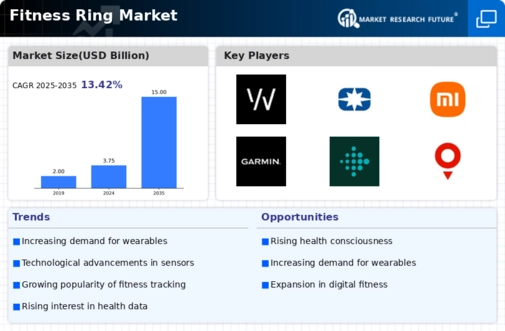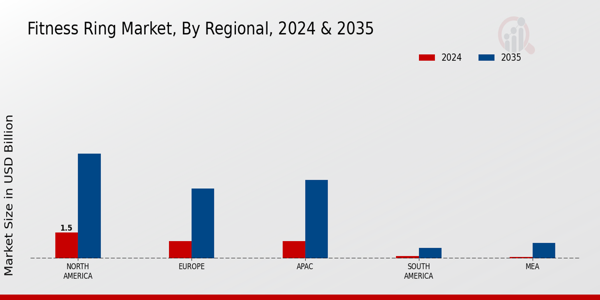Rising Health Awareness
The Global Fitness Ring Market Industry is experiencing a surge in demand driven by increasing health consciousness among consumers. Individuals are becoming more proactive about their health, leading to a greater emphasis on fitness and wellness. This trend is reflected in the projected market value of 3.75 USD Billion in 2024, as consumers seek innovative solutions to monitor their health metrics. Fitness rings, with their ability to track various health indicators, are becoming essential tools for individuals aiming to maintain a healthy lifestyle. This growing awareness is likely to propel the market further as more consumers integrate fitness technology into their daily routines.
Technological Advancements
Technological innovations play a pivotal role in the expansion of the Global Fitness Ring Market Industry. The integration of advanced sensors and connectivity features in fitness rings enhances their functionality, allowing users to monitor heart rate, sleep patterns, and activity levels with precision. As technology continues to evolve, manufacturers are likely to introduce more sophisticated features, appealing to tech-savvy consumers. This trend is expected to contribute to the market's growth, with projections indicating a rise to 15 USD Billion by 2035. The continuous development of wearable technology is thus a significant driver of market expansion.
Market Trends and Projections
Growing Fitness and Wellness Industry
The Global Fitness Ring Market Industry is closely linked to the expanding fitness and wellness sector. As more individuals prioritize physical fitness and mental well-being, the demand for tools that facilitate health monitoring is on the rise. Fitness rings serve as valuable companions for those engaged in fitness activities, providing real-time data and insights. This trend is expected to contribute significantly to the market's growth, with projections indicating a market value of 3.75 USD Billion in 2024. The increasing participation in fitness activities globally suggests a promising future for fitness rings as essential tools for health enthusiasts.
Increasing Adoption of Wearable Technology
The Global Fitness Ring Market Industry is benefiting from the broader trend of wearable technology adoption. As consumers increasingly embrace smart devices, fitness rings are positioned as convenient and unobtrusive options for health tracking. This trend is particularly evident among younger demographics who prioritize fitness and technology integration. The market is projected to grow at a CAGR of 13.43% from 2025 to 2035, indicating a robust demand for fitness rings as part of the wearable technology ecosystem. This growing acceptance suggests that fitness rings will become a staple in personal health management.
Rising Demand for Personalized Health Solutions
The Global Fitness Ring Market Industry is witnessing a shift towards personalized health solutions, as consumers seek products tailored to their individual needs. Fitness rings that offer customized insights and recommendations based on user data are gaining traction. This trend aligns with the increasing desire for personalized health management, where consumers prefer devices that cater to their specific fitness goals. As the market evolves, manufacturers are likely to focus on developing features that enhance user experience and engagement, further driving the growth of the fitness ring segment within the broader wearable technology market.















